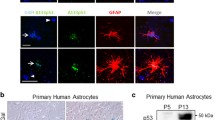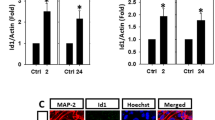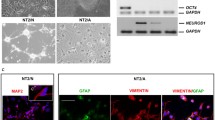Abstract
Background and aims
Cyclin-dependent kinase inhibitor p15INK4b is thought to be an important player in regulating astrocytic cell cycle. However, little is known with regard to the expression of p15INK4b and its function in hippocampal astrocytes. This study evaluated the expression of p15INK4b and its function during different development stages in hippocampal astrocytes.
Methods
In this study, we cultured hippocampal astrocytes from neonatal adult and aged rats. The expression of p15INK4b in neonatal, adult and aged astrocytes was examined. Short interfering RNA (siRNA) was then used to study the functional effects of p15INK4b down-regulation during cell cycle regulation.
Results
We found the expression of p15INK4b in hippocampal astrocytes was detectable on postnatal day 7, was expressed at moderate levels in adult mice (9 months old) astrocytes and peaked in aged rat (24 months old) astrocytes. Incubation with siRNA significantly suppressed p15INK4b expression at the mRNA and protein levels in astrocytes. Down-regulation of p15INK4b increased [3H]-thymidine incorporation into DNA and allowed cells to pass the G0/G1-S checkpoint in aged but not in neonatal or adult astrocytes.
Conclusions
These observations suggest p15INK4b is expressed at a steady level in neonatal and adult rat hippocampal astrocytes with no effect on cell cycle regulation. Importantly, aged astrocyte cell cycle regulation was significantly affected by high expression levels of p15INK4b suggesting a role for p15INK4b in cell cycle regulation when it is expressed at high but not moderate or low levels in hippocampal astrocytes.





Similar content being viewed by others
References
Song H, Stevens C, Gage F (2002) Astroglia induce neurogenesis from adult neural stem cells. Nature 417:39–44
Luu P, Sill O, Gao L et al (2012) The role of adult hippocampal neurogenesis in reducing interference. Behav Neurosci 126:384–391
Zonis S, Ljubimov V, Mahgerefteh M et al (2013) p21Cip restrains hippocampal neurogenesis and protects neuronal progenitors from apoptosis during acute systemic inflammation. Hippocampus 23:1383–1394
Ransom B, Ransom C (2012) Astrocytes: multitalented stars of the central nervous system. Methods Mol Biol 814:3–7
Agnihotri S, Wolf A, Picard D et al (2009) GATA4 is a regulator of astrocyte cell proliferation and apoptosis in the human and murine central nervous system. Oncogene 28:3033–3046
Albright C, Mar M, Friedrich C et al (2001) Maternal choline availability alters the localization of p15Ink4B and p27Kip1 cyclin-dependent kinase inhibitors in the developing fetal rat brain hippocampus. Dev Neurosci 23:100–106
Lin D, Wu J, Holstein D et al (2007) Ca2+ signaling, mitochondria and sensitivity to oxidative stress in aging astrocytes. Neurobiol Aging 28:99–111
Wilhelm C, Hashimoto J, Roberts M et al (2015) Astrocyte dysfunction induced by alcohol in females but not males. Brain Pathol. doi:10.1111/bpa.12276
Fiaschi-Taesch N, Sicari B, Ubriani K et al (2009) Mutant parathyroid hormone-related protein, devoid of the nuclear localization signal, markedly inhibits arterial smooth muscle cell cycle and neointima formation by coordinate up-regulation of p15Ink4b and p27kip1. Endocrinology 150:1429–1439
Joyce N, Harris D, Mello D (2002) Mechanisms of mitotic inhibition in corneal endothelium: contact inhibition and TGF-beta2. Invest Ophthalmol Vis Sci 43:2152–2159
Ganz J, Arie I, Ben-Zur T et al (2014) Astrocyte-like cells derived from human oral mucosa stem cells provide neuroprotection in vitro and in vivo. Stem Cells Transl Med 3:375–386
Jeong H, Ji K, Min K et al (2014) Astrogliosis is a possible player in preventing delayed neuronal death. Mol Cells 37:345–355
Velázquez E, Ruiz-Albusac J, Blázquez E (2003) Glucagon-like peptide-2 stimulates the proliferation of cultured rat astrocytes. Eur J Biochem 270:3001–3009
Velázquez E, Santos A, Montes A et al (2006) 25-Hydroxycholesterol has a dual effect on the proliferation of cultured rat astrocytes. Neuropharmacology 51:229–237
Miranda C, Braun L, Jiang Y et al (2012) Aging brain microenvironment decreases hippocampal neurogenesis through Wnt-mediated survivin signaling. Aging Cell 11:542–552
Lee S, Clemenson G, Gage F (2012) New neurons in an aged brain. Behav Brain Res 227:497–507
Ojo J, Rezaie P, Gabbott P et al (2015) Impact of age-related neuroglial cell responses on hippocampal deterioration. Front Aging Neurosci 29:57
Zhu J, Mu X, Zeng J et al (2014) Ginsenoside Rg1 prevents cognitive impairment and hippocampus senescence in a rat model of D-galactose-induced aging. PLoS One 9:e101291
Bondolfi L, Ermini F, Long J et al (2004) Impact of age and caloric restriction on neurogenesis in the dentate gyrus of C57BL/6 mice. Neurobiol Aging 25:333–340
Nakagawa T, Schwartz J (2004) Gene expression patterns in in vivo normal adult astrocytes compared with cultured neonatal and normal adult astrocytes. Neurochem Int 45:203–242
Arendt T, Holzer M, Gärtner U (1998) Neuronal expression of cycline dependent kinase inhibitors of the INK4 family in Alzheimer’s disease. J Neural Transm 105:949–960
Hindley C, Philpott A (2012) Co-ordination of cell cycle and differentiation in the developing nervous system. Biochem J 444:375–382
Almeida L, Custódio A, Araújo J et al (2008) Mutational analysis of genes p14ARF, p15INK4b, p16INK4a, and PTEN in human nervous system tumors. Genet Mol Res 7:451–459
Fuxe J, Akusjärvi G, Goike H et al (2000) Adenovirus-mediated overexpression of p15INK4B inhibits human glioma cell growth, induces replicative senescence, and inhibits telomerase activity similarly to p16INK4A. Cell Growth Differ 11:373–384
Acknowledgments
We deeply thank Dr. Alyssa Charrier for critical reading and professional revision of our manuscript.
Author information
Authors and Affiliations
Corresponding author
Ethics declarations
Conflict of interest
The authors declare that they have no conflict of interest.
Ethical approval
All applicable international, national, and/or institutional guidelines for the care and use of animals were followed.
Informed consent
Informed consent was obtained from all individual participants included in the study.
Rights and permissions
About this article
Cite this article
Wang, F., Zhang, L. p15INK4b regulates cell cycle signaling in hippocampal astrocytes of aged rats. Aging Clin Exp Res 28, 813–821 (2016). https://doi.org/10.1007/s40520-015-0484-3
Received:
Accepted:
Published:
Issue Date:
DOI: https://doi.org/10.1007/s40520-015-0484-3




